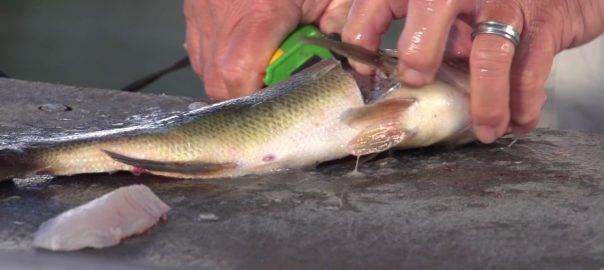
How to Clean & Prep a Freshly Caught Fish
Summer Grilling Tips: How to Clean and Prep a Fresh Fish
There’s a certain thrill that you get from reeling in a big fish. For many anglers, catching their dinner for the first time feels like something of a rite of passage, and hearkens back to simpler times. Going fishing with the intent of catching your dinner can be an exhilarating experience, filled with highs and lows as the unpredictable nature of fishing puts your skill and patience to the test. However, when you do reel in that beautiful fish and you know you’re going to eat well tonight, your mind may turn to how to actually cook it and make a good meal out of it.
Fortunately, the process of cleaning and preparing a fresh fish for cooking isn’t overly difficult. There are a few guidelines that you will want to keep in mind, some tools you’ll want to have handy, and a few tips and tricks to help make things even easier. Pretty soon you’ll be a seasoned pro at preparing a perfect fillet or steak from a freshly cleaned fish.
Before we get to the steps on how to prep your fish, there are a couple of important things we need to cover…
Know the Fish & Follow the Rules
First and foremost, one of the most important things to know about catching fish to eat is that there are some rules that you need to follow that have been set by federal and provincial governments in order to protect you, as well as the environment, from any negative effects such as contaminants, wildlife and fish population control, protected species, and more.
Be sure to familiarize yourself with these rules, which can easily be found online. For example, here is the Guide to Eating Ontario Fish for 2017/18, which is easy to follow and contains plenty of helpful information for Ontario sport fishing enthusiasts.
In addition, you’ll need to ensure you have purchased a fishing license. There are several different tiers available depending on how many fish you want to keep, and how often you’ll want to get out fishing this summer.
Check out the Ministry of Natural Resources website for details on what license options exist, and for the rules of fishing here in Ontario (download the PDF doc). Be sure to take a few minutes to fully read the latter, as it’ll save you from hefty fines for not obeying seasons, and other fishing rules designed to protect the environment.
Now that you’re aware that there are some essential rules of fishing, how do you know whether the fish you were lucky enough to have caught is actually going to make a good meal? It’s true that some fish just don’t make for a very pleasant meal, so it’s important to know what you’re working with before you invest too much time and effort in to planning a big dinner around a fish that should have probably just been thrown back.
The variety of fish in your area will be different than those found in other areas, but there are plenty of resources that you can refer to that help you know what types of fish to expect in certain areas of the country. For example, this interactive map from the Government of Ontario can help you determine where to find certain species in the province.
If you have questions about the best local fishing spots or what you’re most likely to catch in certain areas, pop in to your local tackle shop or outdoor gear supply store and ask the staff in the fishing section for advice. They’ll be able to point you in the right direction.
Some of the most common types of freshwater sporting fish in Canada that are also ideal and popular for eating include:
- walleye
- perch
- bass
- pike
- trout
- salmon
- and other panfish, which are all lighter fish with lower fat content.
Depending on the fish you catch, you may have to have a couple of meal ideas in mind to pick from that will best suit different types of fish.
Tools You’ll Need
While you don’t need a ton of supplies to clean a fish, there are a few essentials that you will want to have close at hand before you begin.
Ice Chest or Cooler – To make sure your fish stays as fresh as possible, you’ll want to store it in ice until you’re ready to clean it. As well, you’ll want to keep your fish fillets or steaks chilled and on ice until you’re ready to cook, so a spare cooler designated specifically for fish, and filled with ice is very important if you are away from your kitchen fridge.
Filleting Knife – This long, thin knife needs to be kept very sharp in order to produce the best results. Since fish meat tends to be a bit more delicate than chicken or beef, a dull knife will cause the meat to rip and tear, resulting in a rough-looking fillet.
Large Cutting Board – Having a stable surface that gives you a comfortable amount of space to work with makes cleaning the fish and preparing your steaks and fillets much easier. You’ll want a solid cutting board that won’t slide or slip while you work.
If you’re staying in the wilderness, either camping or in a cottage, where a bear encounter is possible, then it’s extremely important that you NOT clean your fish close to your tents, or cottage.
Bears have an incredible sense of smell and the smell of a messy fish cleaning station can lure them in. So make sure that you do a full clean up when you’re done, getting rid of all the scraps in bear proof rubbish receptacles.
How to Clean a Fresh Fish
Start with the fish resting on its side with the belly facing you. Begin by inserting your fillet knife so it just pierces the skin slightly above the anal opening of the fish.
Cut the belly of the fish in a smooth, steady motion towards the head, making sure not to insert the knife too deep in to the body in order to avoid cutting in to the intestines and other organs.
Spreading the body open, pull all the organs and entrails out of the fish, including the anus of the fish which should be cut away from the body using your fillet knife.
Once the innards of the fish have been completely removed, thoroughly rinse the fish inside and out. At this point, you are ready to cook the fish whole, or cut it up in to either fillets or steaks, depending on how you intend to cook and serve it.
To cut the fish in to steaks, use a large, sharp kitchen knife to cut the fish into steaks, starting just behind the head and gills. Fish steaks are usually cut about 1” thick on average, but this is entirely up to you. Thicker steaks can be trickier to cook without drying them out, so be careful not to get too carried away with making a super-thick fish steak. Salmon and Trout are well suited for steak cuts.
To cut the fish in to fillets, you start at the tail, leaving just enough for you to hold onto. Then using a slow back and forth motion, while trying to keep the knife as close to the backbone as possible, you work your way towards the head of the fish.
Once you’ve got your fillet separated from the fish, you can remove the skin at this time if you prefer. Simply place the fillet skin-side down on your cutting board and run the fillet knife under the meat and stay close to the skin as you cut.
This is why it’s important to have a proper filleting knife – long, thin and SHARP!
This method is used for a variety of fish types, and is particularly well suited for pickerel/walleye, perch and even bass.
There are tons of great videos on YouTube about how to fillet a fish. Each type of fish requires a slightly different technique, so do some specific searches using the type of fish you’ll be catching.
Now you’re ready to start cooking your fresh fish! The only question you have to answer now is how are you going to do that? You could keep things simple by adding a little bit of oil and fresh lemon juice, or kick things up with this delicious No Salt Gone Fishing Rub from Summer Kitchen.
Check out all the other interesting spices and seasonings you can select from at The Low Carb Grocery. Whatever you choose to do with your fish, we are sure that everyone at your table will appreciate the effort you put in to the meal.
Conclusion
As you can see, cleaning a fresh fish isn’t really all that tricky. Plus, what you’ll find is that the taste of a fish caught fresh with your very own rod and reel is unlike anything else.
There’s a great sense of pride and satisfaction that comes with being able to catch, clean and cook your own dinner, and it’s a great way to connect on a more personal level with nature. Many families enjoy fishing together, and it’s a wonderful way to add a new level of adventure to your next camping trip.
We hope that you’ve found this information helpful, and that you have a lot of good luck the next time you cast a line.






